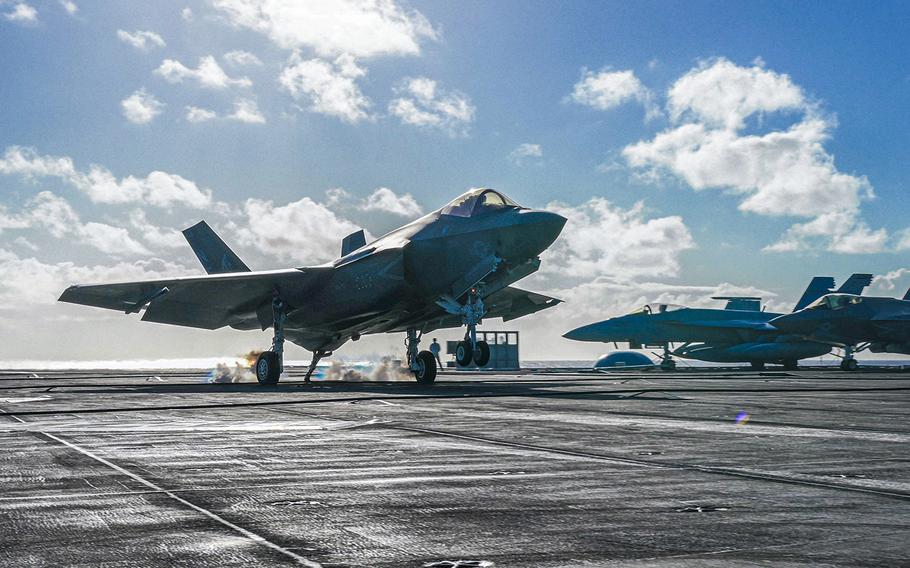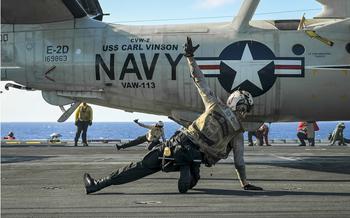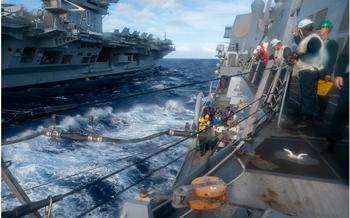
A U.S. Navy F-35C Lightning II launches from the USS Carl Vinson during RIMPAC exercises in Hawaii on July 15, 2024. (Jerreht Harris/U.S. Air Force)
As the biennial exercise Rim of the Pacific continues off the coast of Hawaii, the U.S. Navy’s Carrier Strike Group 1 has been practicing flight operations from its flagship the USS Carl Vinson.
Throughout last week a revolving door of dignitaries ranging from U.S. Rep. Jill Tokuda to admirals from Canada and Mexico were ferried to the ship aboard V-22 Osprey “tilt-rotor ” aircraft to watch as crews practiced launching aircraft from the Vinson’s deck and receiving them for landing once they returned. Journalists—both local Hawaii reporters and international press in the islands in the exercise—were also brought aboard.
“We are deployed here with what we call the air wing in the future, ” carrier strike group commander Rear Adm. Michael Wosje told a group of reporters aboard the ship Friday.
The ship has a mixture of F-18 fighters as well as advanced new F-35 aircraft on its deck, along with helicopters and other support aircraft. They’re training with the rest of the international gathering of warships and aircraft that have come to Hawaii to train.
The Carl Vinson has a crew of just under 5, 000 sailors and has about 75 aircraft assigned to it, stacked above and below deck as they swap between operations and maintenance. The Vinson is one of 11 aircraft carriers in the U.S. military’s massive arsenal, which are regarded by many strategists as the Pentagon’s most powerful tools.

A U.S. Navy E-2D Advanced Hawkeye launches from the USS Carl Vinson during RIMPAC exercises in Hawaii on July 15, 2024. (Jerreht Harris/U.S. Air Force)
At RIMPAC they’re learning how to use the carrier to work more closely with other militaries to land and launch their own aircraft on the Vinson. Chief Petty Officer Pocy Allen, a 25-year Navy veteran from Pearl City assigned to the Vinson, said it’s “a very unique experience ” to see the flurry of aircraft coming and going, and said she’s met sailors from across the world throughout the exercise aboard the carrier.
“That just gives us an opportunity to make sure that … we understand the tactics, techniques and procedures together, so that we have the opportunity to operate together, ” Wosje said. “You have controllers from a bunch of different nations’ ships … and of course, aircraft from this aircraft carrier, all integrating together to provide a collective picture and be able to support one another out here in the Pacific.”
He told reporters that he had just returned to the Vinson after flying out to the Dutch navy’s frigate HNLMS Tromp, the first ship the Netherlands has ever sent to RIMPAC.
“I got to watch our helicopter crews integrating with their helicopter crews, got to watch their air controllers getting ready to work with aircraft that we’re going to be launching from here, ” said Wosje. “(It’s ) so awesome to see nations coming all the way from Europe to participate in a major exercise like this as part of Rim of the Pacific.”
Germany and Italy also sent warships to this year’s RIMPAC for the first time as countries is Europe show increasing interest in the Pacific amid tensions along key trade routes and as China continues to build up its military might and global influence.
Wosje said when he spoke to Dutch sailors aboard the Tromp who are used to operating in the Atlantic and occasionally around the Persian Gulf, they told him that “(to ) just see the vast openness of this operating area, (it’s ) very eye-opening, and how much transit time and operating time is required in a large operating area that we see here in the Pacific.”

The USS Carl Vinson conducts a refueling at sea with the USS Sterett during RIMPAC exercises in Hawaii on July 21, 2024. (Ezekiel Duran/U.S. Navy)
RIMPAC takes place as the world’s oceans are becoming more violent. When Russia launched a full-scale invasion of Ukraine in 2022, violence spread into the Black Sea, where Ukrainian and Russian forces have faced off with ships, missiles and drones. Though the Russian navy has pounded Ukrainian ports and coastlines, inflicting heavy military and civilian casualties, Ukrainian forces have inflicted heavy losses on the Russian navy as well and have even struck Russian ports.
In the Red Sea, Islamist Houthi militants in Yemen have attacked merchant ships in the Red Sea with a mixture of shore-based missiles and drones, helicopters and boats. The group says the attacks are intended as an act of solidarity with Palestinians as Israel continues to wage an offensive in Gaza that has leveled entire neighborhoods and killed thousands in retaliation for the Oct. 7 massacres in Israel by the militant group Hamas.
The Houthis have pledged to attack any ship they believe is traveling to or from Israel, but have also routinely attacked ships that don’t have clear ties to Israel or the conflict. A U.S.-led international naval task force has been operating in the Red Sea to ward off the attacks. The Tromp participated in that mission before arriving in Hawaii for RIMPAC.
Wosje said that when they train they treat operations as if they’re the real thing, saying that RIMPAC offers a “very realistic ” training environment.
In the Pacific, China has been building up its military forces and by some estimates now has the world’s largest navy. It has used those forces to assert its claims over the South China Sea, a critical trade route that more than a third of all international trade travels through.
Beijing claims the entire sea as its exclusive sovereign territory over the objections of its neighbors, while the Chinese military has built bases on disputed islands and atolls as well as harassed and attacked vessels from neighboring countries. The U.S. for its part has sent aircraft carrier groups on regular “freedom of navigation operations ” in the region over China’s objections.
As the Vinson arrived in Hawaii in June, the Chinese navy’s Shandong Carrier Strike Group sailed into the Philippine Sea. Though the Chinese navy has grown, it has only two active aircraft carriers and has been working to build up and operate more. But the Chinese military has also in recent years worked to develop so-called carrier killer missiles specifically to destroy ships like Vinson. Military analysts warn these threats could make large carriers uniquely vulnerable and upend the balance of power in the Pacific.
When asked whether the potential emergence of that technology influences RIMPAC training, Wosje said, “We are obviously cognizant of emerging missile threats, we do obviously study very closely operations globally, what the Houthis are doing in the Red Sea, as well as various other parts of the world. We take that into account, and we obviously develop tactics, techniques and procedures.”
Diplomats in the Pacific have been working to prevent escalation as recent confrontations between China and neighboring countries have raised concerns of potential conflict in the region.
On Sunday, China and the Philippines announced they had reached a “provisional agreement ” aimed at cooling tensions that have been escalating in recent months over territorial rights, including a violent confrontation between the Chinese coast guard and Philippine navy in June that left a Philippine navy sailor seriously injured during a mission to resupply Philippine troops at an outpost on a disputed shoal.
(c)2024 The Honolulu Star-Advertiser
Visit The Honolulu Star-Advertiser
Distributed by Tribune Content Agency, LLC.